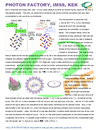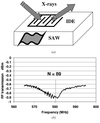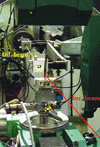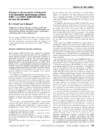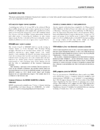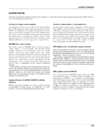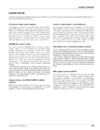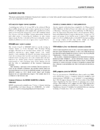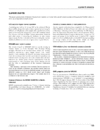issue contents
March 2002 issue

Cover illustration: Simulated speckle pattern of the domain structure of a GdFe2 film, see Mentes, Sánchez-Hanke and Kao, pages 90-95.
facility information
obituaries
Free 

research papers
X-ray pulses from the Advanced Photon Source at Argonne National Laboratory were used to measure the speed of X-rays in the energy range between 21 and 60 keV.
Limits and potentiality of anomalous small-angle X-ray scattering for the investigation of supported metal catalysts are discussed. Optimized experimental conditions and measuring strategy are proposed, and data-evaluation methods for obtaining quantitative reliable results are suggested.
Synchrotron fibre diffraction reveals the changes that occur in the connective tissue of the breast in the lead up to breast cancer. These changes are not associated with the fibrillar collagens but rather with collagen type IV.
The measurement of strain in engineering specimens and components using white-beam energy-dispersive synchrotron X-ray diffraction is described. Fast and efficient data collection and interpretation procedures allow detailed and accurate spatial maps of strains to be collected.
The crystal reflection of short X-ray pulses in Laue geometry is simulated by Fourier transforms using the steady-state solutions from dynamical theory.
Direct crystal chemistry characterization of rare-earth elements at trace levels in natural garnets has been obtained by means of Nd K-edge X-ray absorption near-edge structure spectroscopy, not available in the literature. The capability of high-energy XANES as a powerful structural tool providing structural details unattainable by using standard methods is demonstrated.
A non-destructive technique for imaging magnetic domains based on the multiple-wavelength anomalous diffraction method is proposed.
The optical switching of X-rays has been demonstrated using the Bragg peak shift by laser-induced lattice expansion with a response time of a few hundred picoseconds. A single pulse was extracted from the synchrotron radiation pulse train using a double-crystal arrangement of GaAs, in which the two crystals were irradiated by way of two successive laser pulses with an appropriate time delay.
The performance of a newly developed fast fluorescent ion chamber is presented. The time response and available frequency range of the chamber are evaluated.
letters to the editor
Free 

The proceedings of BIOXAS 2001 (Siena, Italy, 2001) and both current and planned activities in the field of biological X-ray absorption spectroscopy are discussed against the perspective of changes in the perception of the technique since ICBIC 1 (Florence, Italy, 1983).
current events
Free 

Free 

Free 

Free 

Free 

Free 



 journal menu
journal menu













